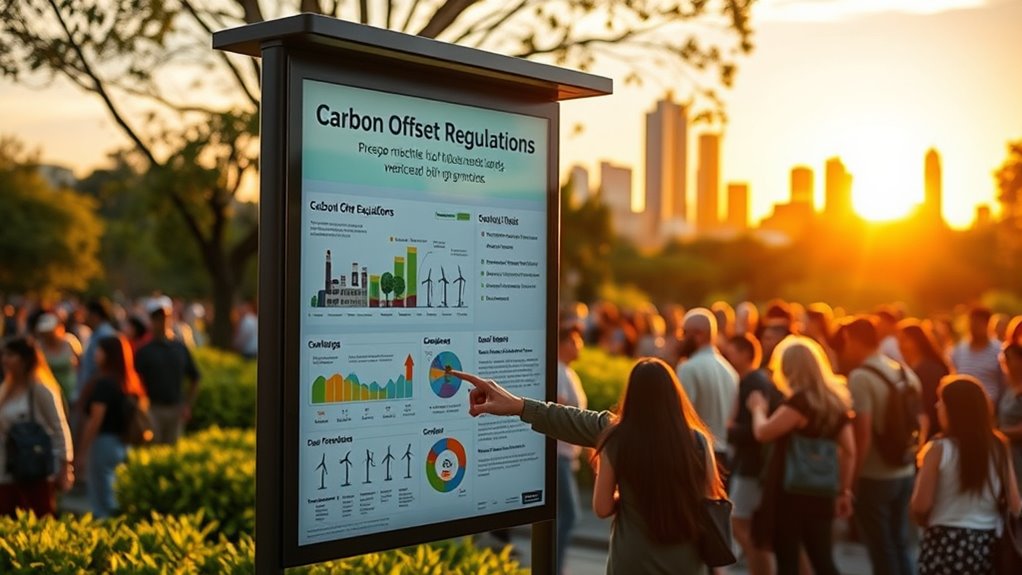To cut through the confusion around carbon offset regulations, it’s vital to understand that standards guarantee offsets are genuine and verifiable. These rules prevent greenwashing by setting clear criteria for project validation, monitoring, and reporting. International agreements and government policies help create a trustworthy market, making sure your contributions truly reduce emissions. Staying informed about these regulations protects your reputation and makes certain your environmental efforts are impactful—if you want to deepen your knowledge, there’s more to discover.
Key Takeaways
- Understand international standards like the Paris Agreement to ensure global compliance and recognition of carbon offsets.
- Verify that projects are independently audited and monitored to confirm genuine emission reductions.
- Recognize regulations prevent greenwashing by setting clear definitions and strict eligibility criteria for offsets.
- Stay informed about evolving legal frameworks to maintain compliance and avoid reputational risks.
- Choose offsets from certified programs that adhere to transparent standards and safeguarding measures.

As concerns about climate change grow, governments and organizations worldwide are implementing regulations to govern carbon offset programs. These rules aim to guarantee that offsets genuinely reduce emissions and support global efforts to combat warming. One key aspect of these regulations involves understanding how carbon credit mechanisms function. Essentially, carbon credits are certificates representing a specific amount of carbon dioxide either avoided or removed from the atmosphere. When you purchase a carbon offset, you’re investing in projects like reforestation or renewable energy, which generate these credits. Regulations often set strict standards for these mechanisms to prevent ‘greenwashing’—where claims of environmental benefits are exaggerated or misleading. By clarifying what qualifies as a valid offset, governments help you make more informed decisions and ensure your contributions are impactful. Additionally, clear standards and definitions are vital for maintaining the credibility of carbon markets, ensuring participants can trust the validity of the credits they acquire.
International compliance plays a significant role in this landscape, especially for businesses operating across borders. Countries and organizations are aligning their standards through frameworks like the Paris Agreement, which encourages transparency and consistency in carbon offsetting. If you’re involved in international trade or emissions management, you need to be aware of these compliance requirements. They dictate how your offsets are recognized globally and ensure that your efforts meet both local and international expectations. This alignment also helps prevent double counting, where the same emission reduction gets credited more than once, undermining the credibility of offset programs. When regulations enforce international compliance, they create a level playing field, making it easier for you to participate confidently in carbon markets without fear of inadvertently violating rules or damaging your reputation.
Furthermore, these regulations influence how carbon offset projects are verified and monitored. You’ll find that credible programs require third-party audits and transparent reporting to validate claims. This process ensures the projects generating credits actually deliver the promised emissions reductions and adhere to established standards. As a participant, you benefit from these safeguards because they protect you from investing in ineffective or fraudulent projects. They also help maintain the integrity of the carbon market, making it a more reliable tool for your sustainability goals. Ultimately, understanding the role of carbon credit mechanisms and the importance of adhering to international compliance helps you navigate the complex regulatory environment with confidence. It empowers you to support genuine emission reductions and contribute meaningfully to global climate action, all while staying within the boundaries of evolving legal frameworks.
Frequently Asked Questions
How Do International Carbon Offset Standards Differ?
When you look at international carbon offset standards, you’ll notice differences in how they set criteria and verify projects. Standard differences include scope and stringency, affecting credibility. Certification variations mean some standards require third-party verification, while others don’t. These variations can impact your confidence in offsets’ effectiveness. Understanding these differences helps you choose reliable offsets, ensuring your climate actions are genuine and impactful across different countries and projects.
What Are the Penalties for Non-Compliance?
Did you know that non-compliance penalties can reach up to $50,000 per day? If you ignore regulations, you risk hefty fines, especially if your offset project lacks proper certification. Penalties vary depending on the severity and jurisdiction, but they often include fines, suspension of carbon credit trading, or project shutdowns. Staying compliant guarantees your project benefits from fair carbon credit pricing and is recognized through proper offset project certification.
Can Individuals Participate in Carbon Offset Programs?
You can definitely participate in carbon offset programs, and doing so can have a positive personal impact by reducing your carbon footprint. Look for offset certification to guarantee your contributions are credible and effective. By choosing certified programs, you support genuine environmental projects. Your participation not only helps combat climate change but also encourages others to take responsible actions, making a real difference in the collective effort to protect the planet.
How Transparent Are Offset Project Verifications?
You might wonder how transparent offset project verifications are. Verification challenges can make it tricky to trust the claims made by offset projects, but transparency initiatives are working to enhance this. These efforts aim to ensure that projects are accurately measured and genuinely reduce emissions. By supporting programs with strong transparency initiatives, you can better ensure your offsets are reliable and truly contribute to environmental goals.
What Future Regulatory Changes Are Anticipated?
You’re curious about future regulatory changes and their market impacts and policy implications. You can expect increased standards for verification and transparency, which might raise costs but improve credibility. Governments could introduce stricter reporting requirements, influencing how you purchase and verify offsets. These changes aim to ensure environmental integrity, but they may also create market shifts, encouraging innovation and greater accountability in offset projects. Staying informed will help you adapt to these evolving regulations effectively.
Conclusion
Guiding carbon offset regulations is like steering through a foggy night—uncertain but essential. As you clear the haze, remember each regulation is a guiding star, illuminating your path toward sustainability. Embrace the journey, knowing your choices are the brushstrokes painting a greener future. With every step, you become a lighthouse for change, shining hope across the dark waters of climate uncertainty. Stay committed, and let your actions be the compass that leads us all home.









